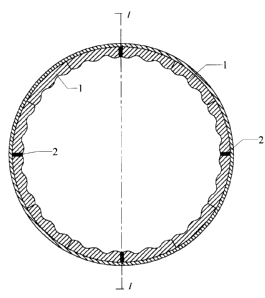Note: Descriptions are shown in the official language in which they were submitted.
CA 02305481 2000-04-14
Self fastened Ball Mill Liner
BACKGROUND OF THE INVENTION
Ball mills are widely used in the cement industry, coal-fired power plants,
mines and chemical industry. Ball
mill liners using durable metal are installed inside the cylinder, usually
using numerous bolts. These bolts go
through holes that are on the liners and fasten the liners to the mill's
cylinder. During operation, with the
rotation and vibration of the cylinder, bolts break frequently. Also, liner
breakage occurs along the liner's
hole. Research shows that most of the broken liners are due to casting
stresses and annealing fractures
concentrated around the bolt holes of the liners, and in the same time, holes
on the liners have to bear all the
impacting and banding forces. It is known that the harder the metal material
is, the more casting stresses will
occur and the easier break. Traditionally, to avoid breakage, ball mill liners
are usually made of middle
hardness metal such as high manganese steel. The HRC value of the high
manganese steel is only about 30,
and as a result, these liners are not really durable. A mufti-cast technology
to produce liners has been
attempted, but the production process is complex and the quality of mufti-cast
liners is not stable. Moreover,
this kind of liner still needs bolts to fasten them on the cylinder. In fact,
using mufti-cast liners could not
solve the problem of bolt breakage and liners breakage. The goal of this
invention is try to completely
improve liner for ball mills; that is, use really hard material to build
liners, prevent liners from breaking, solve
the problem of bolt breakage, and make the installation easier.
DESCRIPTION OF PRIOR ART
It is known in the prior act to provide improved liner, US patent Number
4,580,734, which issued to Richard
E. Erosdey on July 2, 1984, discloses a sectional liner.
DETAILED DESCRIPTION AND SUMMARY OF THE INVENTION
The self fastened liner pertains to new structure and new material liner for
ball mills. This kind of liner
consists of Main Plates 1 and Wedging Plates 2 (see Figure 1 and Figure 2).
All these Plates are designed as
no hole Plates. Based on arch geometry theory, Main Plates 1 are fastened by
Wedging Plates 2 inside of ball
mill cylinder. When the ball mill is rotating, balls inside of the mill
cylinder shall impact these Wedging
Plates continually, therefor all these Plates become firmer and firmer.
Experiments show that following long
periods of operation using self fastened liner, all Plates nearly formed one
integral unit, without any liner
breakage. Because there is no hole on these Plates, this design can eliminate
casting stress and annealing
fracture. Therefor, Main Plates can be made of glass-hard steel or even
porcelain. When using glass-hard
steel to build Main Plates and with the absence of any bolt fasteners, it is
clear that self fastened liner can last
a long time and eliminate bolt breakage which commonly occurs with traditional
ball mill liners.
Main Plates of self fastened liner are made of glass-hard steel, such as high
and middle chromium steel,
martensitic iron or porcelain. The function of the Main Plates is resisting
attrition. Size of the Main Plates is
_I_
CA 02305481 2000-04-14
based on the demands of ball mills, but the geometrical form of the Main
Plates is as illustrated as Figure 1
and Figure 2. Top surface of the Main Plates could be designed as curved
surface.
The Wedging Plates are made of mild steel, such as normal lower carbon steel
or even hard rubber. The
function of the Wedging Plates is fastening. Width of the Wedging Plates is
from 3mm to 140mm according
to the diameter of mill cylinder. External form of the Wedging Plates is
perspective of axial section and radial
section of the Main Plates. During the installation, Main Plates and Wedging
Plates are simply combined
together.
The self fastened liner has already been used for several 3.80 meter diameter
ball mills and several rotary
pulverizers in different coal-fired power plants and some cement plants. The
results in actual production are
excellent; the lifetime of the invented liner is at least three times as long
as that of traditional liners, no liner
breakage occurs and maintenance work is decreased greatly.
BRIEF DESCRIPTION OF THE DRAWINGS
Figure 1 is a radial section view of the liner of the present invention.
Figure 2 is a cross-section of the line I I of Figure 1.
BRIEF DESCTIPTION OF THE PICTURES
Picture lshows that the self fastened liner has just been installed.
Picture 2 shows that the self fastened liner is still in good condition after
28,080 hours operation.
-2-
